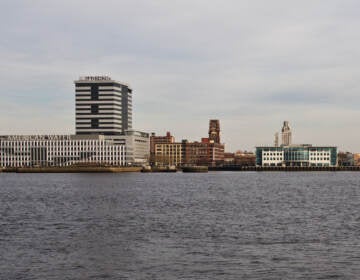What went wrong with N.J.’s ‘Stronger Than The Storm?’

Part of the STTS campaign included merchandise like this onesiefor $14. (Image from STTS website)
Despite maintaining a near-constant TV presence, the much-ballyhooed Stronger than the Storm promotional campaign debuted too late to make enough of an impact on summer tourism, according to leaders in the state’s tourism industry.
Testifying at an Assembly tourism and arts committee hearing yesterday, destination marketing and economic development officials lauded the program’s modest successes but criticized its narrow scope and short run. They also called on the government to better fund the state’s official tourism arm and establish a sustained promotional campaign to bring more visitors back to the Shore.
The $25 million project launched in May with funding from a Housing and Urban Development recovery grant. The effort, which still maintains its website and social media activity, relied heavily on TV, radio, and Internet advertising to promote the Jersey Shore as “open for business” in advance of the summer season. But with a typical 90-to-120 day advance window for Shore bookings, disappointed speakers complained that the blitz should have started at the beginning of the year.
Still, there were some bright spots that broke through the general gloom — Asbury Park made a very strong showing, for instance. But for the most part, widespread anecdotal evidence indicates a nearly nonexistent spring, or “shoulder,” season, an extremely slow (albeit rainy) June and July, and strong gains in August that lasted through the fall but don’t inspire confidence for celebratory year-end numbers.
“In January I asked (this committee) for an immediate $20 million infusion for crisis marketing to take control of the message,” testified Vicki Clark, president of the Cape May County Chamber of Commerce and vice president of the New Jersey Travel Industry Association. “Without it, we had no way to counteract the (destructive) messages delivered to our customers through media.
The media, she said, spent months portraying the Shore as one long sandy strip of devastation and heartache. And though the southern portion of the coast was largely spared, “The farther away people are, the more they consider the Jersey Shore as one place,” said Clark.
Delaware, Maryland, and Virginia seized on the opportunity the disaster presented. Almost immediately, New Jersey’s Mid-Atlantic neighbors broadcast commercials designed to prey on the fears of vacation-goers scared away by images of crushed rental properties, shredded boardwalks, and roller coasters swept out to sea.
An Ocean City, MD, commercial introduced a lifeguard who promised to “rescue” Jersey Shore regulars and take them to their new vacation destination. A USA Today article published in early August quotes tourism officials in those states claiming that they simply wanted to alert vacationers that their own beaches were not affected by Sandy. The same article cites those officials as seeing a 20 percent increase in the number of information requests coming from New Jersey and New York.
The New Jersey Division of Travel and Tourism won’t release its own economic impact tallies until next March, though the treasury department reports that hotel occupancy tax collections actually increased over June, July, and August. However, the state’s southernmost coastal county, Clark said, reported declines in beach tag and parking fees, as well as employment and vacation home purchases.
“I can’t say Stronger than the Storm was specifically helpful to Cape May County,” she said.
She, along with others who represented lesser-hit parts of the state, protested that the campaign focused too narrowly on Ocean and Monmouth counties and didn’t do enough to present other areas as relatively unscathed. Michael Davidson, executive director of the Greater Newark Convention & Visitors Bureau added that the Stronger Than the Storm website, which advertises Shore attractions and events instead of steering visitors to the tourism department’s comprehensive VisitNJ.org site, was “a missed opportunity for the rest of the state.”
He told the committee that his experience working as a tourism official in Connecticut, New York, and Washington taught him that tourism campaigns work best when state officials promote their territory as a single destination. After prospective travelers take an interest, he said, regional destination-marketing organizations can more easily help them take the next step by facilitating connections to local attractions, lodging, and entertainment.Despite the campaign’s limitations, speakers agreed that they succeeded in presenting New Jersey positively and capturing attention across the state and in the many national and Canadian media markets where they ran. But the state missed another opportunity, they said, by pulling them off-air too soon. Instead of ending the run on Labor Day weekend, as it did, the state needs to coordinate ongoing outreach that will carry its tourism industry safely through the next five years — the amount of time it often takes to fully repair the reputation of an area hit by a natural disaster.
Robert Hilton, who heads the convention and visitors bureau for Ocean and Monmouth, said that despite the late summer and autumn surge in hotel occupancy, overall he considers the summer to have been “absolutely a disaster.” What’s worse, he calls this the most dead December on record. One out of 10 businesses in the counties’ small downtowns are thinking of closing in January and not reopening.
“The folks in my area are scared. They survived the storm and a year later they’re going to close because they can’t get the foot traffic? That just isn’t fair,” he said. “We need an immediate marketing campaign to start in January.”
The governor’s office hasn’t publicized the cost of the campaign so far or whether it plans to go after more federal grants for this purpose. The travel and tourism division runs its own programs but hasn’t told the tourism community when it will unveil its 2014 plans.
The agency is severely limited. It receives a minimum of $9 million per year from a hotel occupancy tax created in 2003 but gets no other funding for promotional activities. A few weeks ago the Assembly tourism and arts committee released a bill that would increase this required minimum. The state can allocate a higher proportion of occupancy fees to tourism, but since the recession funding for tourism marketing has remained stagnant, with the undedicated remainder of the fee helping to supply the general fund.
Assemblywoman Celeste Riley (D-Cumberland), who’s been temporarily chairing the committee since Matthew Milam (D-Vineland) resigned from the Assembly earlier this year, supports an increase in funding for this purpose and asked speakers to propose alternative solutions to raising the minimum allocation.
Davidson suggested the state might create a dedicated revenue source for the tourism department by siphoning off a small percentage of taxes generated by hospitality-related businesses. Speakers also recommended that future promotional messaging emphasize overnight visits as a way to boost income from the occupancy tax. Although it’s been several years since the agency has received more than the minimum $9 million annual disbursement, it’s possible for governors to devote an additional fixed portion or percentage of occupancy tax collections to the tourism bureau. Therefore, in theory, more hotel stays today could translate to more money to promote future hotel stays tomorrow.
Riley has promised to recommend a task force to figure out how to improve tourism marketing and build any victories to be found among the litter of this year’s tourist season. They’ll likely start by questioning Asbury Park Chamber of Commerce officials who shared that the resurgent seaside city has enjoyed an “amazing” year.
And if Hilton is involved, he’ll readily reiterate his position that the medium matters. He told the committee that visitors age 40 to 65 did not believe the positive stories they read in Stronger Than the Storm’s social media posts, which formed a major and relatively inexpensive part of the campaign’s strategy. But did they trust reports in the newspapers and on TV. Thankfully, many called his office to verify, which allowed staff to present a positive spin, he said.
Older visitors continued to have “extensive misperception issues” because they didn’t engage at all with the social media messaging. That may help to explain why Ocean and Monmouth counties welcomed a relatively large number of 21-to-40-year olds who responded strongly to social media messaging (especially the Twitter hashtag #STTS) and according to Hilton, formed “good memories and will return.”
_______________________________________________
NJ Spotlight, an independent online news service on issues critical to New Jersey, makes its in-depth reporting available to NewsWorks.
WHYY is your source for fact-based, in-depth journalism and information. As a nonprofit organization, we rely on financial support from readers like you. Please give today.




